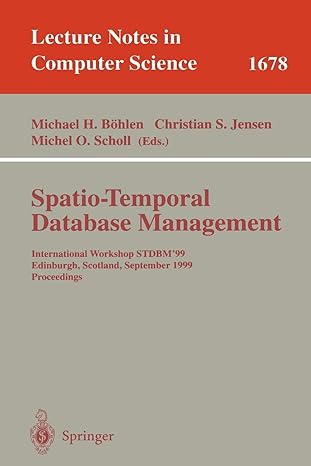Question
WRITE USING C++ PLEASE Task For this project, you have been provided an implementation of the Huffman tree construction algorithm (DO NOT modify this code.
WRITE USING C++ PLEASE
Task
For this project, you have been provided an implementation of the Huffman tree construction algorithm (DO NOT modify this code. It is possible to construct multiple Huffman trees with the same message if numerous characters in the message share the same frequency value. The construct function that I set up ensures that your Huffman tree will produce results consistent with the test cases used for grading). This algorithm utilizes a templated min heap class that you must implement. You must also implement a function that prints the Huffman encoding of message using the Huffman tree constructed from the same message. Specifically, you must implement the following functions:
Input
Input is read from the keyboard. The first line of the input will be an integer t > 0 that indicates the number of test cases. Each test case will contain a message on a single line to be processed by the Huffman tree construct function. Each message will contain at least 2 characters.
Output
For each test case, print Test Case: followed by the test case number on one line. On another line, print the Huffman encoding of the input message. Separate the individual character encodings by a space.
Sample Test Cases
Use input redirection to redirect commands written in a file to the standard input, e.g. $ ./a.out < input1.dat.
Input 1
3
opossum
hello world
message
Output 1
Test Case: 1
11 00 11 10 10 011 010
Test Case: 2
010 011 10 10 00 1100 1101 00 1110 10 1111
Test Case: 3
011 10 11 11 010 00 10
Timing Analysis
At the top of your main file, in comments, write the time complexity of constructing a Huffman tree with a min heap in terms of the number of characters in the input message, which you can denote as n. Also consider the time complexity of constructing a Huffman tree without a min heap. Specifically, what running time can you expect if you use a linear search to find minimum frequencies. Write these time complexities using Big-O notation.
CODE GIVEN:
main.cpp
#include
int main(int argc, char** argv) { // Create a HuffmanTree object and read the input messages into the // HuffmanTree construct function. Next, print the encoded message. // Finally, destruct the huffman tree and move on to the next test case. }
huffman_tree.cpp
#include
void HuffmanTree::construct(const string message) { this->message = message;
// Count the frequency of each letter in message // e.g. // message == "aaabbccccdd" // frequencies == {a:3, b:2, c:4, d:2} map
// Create HuffmanNode for each unique letter in message // and organize nodes into a min heap // e.g. // heap == // {b:2} // / \ // {d:2} {a:3} // / \ / \ // {c:4} MinHeap
// Combine nodes with smallest frequency and insert // back into heap until heap size == 1. Along the way, // create binary tree out of combined nodes. // e.g. // (1) // {b:2} == heap.extract_min() // {d:2} == heap.extract_min() // parent == // {*:4} // / \ // {b:2} {d:2} // // heap == // {a:3} // / \ // {c:4} {*:4} // // (2) // {a:3} == heap.extract_min() // {c:4} == heap.extract_min() // parent == // {*:7} // / \ // {a:3} {*:4} // // heap == // {c:4} // / // {*:7} // // (3) // {*:4} == heap.extract_min() // {*:7} == heap.extract_min() // parent == // {*:11} // / \ // {c:4} {*:7} // / \ // {a:3} {*:4} // / \ // {b:2} {d:2} // // heap == {*:11} while (heap.size() > 1) { HuffmanNode *left, *right;
left = heap.extract_min(); right = heap.extract_min();
HuffmanNode *parent = new HuffmanNode( left->frequency + right->frequency );
parent->left = left; parent->right = right;
heap.insert(parent, parent->frequency); }
// Get root of huffman tree. e.g. {*:11} this->root = heap.peek(); }
void HuffmanTree::print() const { // need to implement this function // Print the Huffman encoding of this->message. // Append 0 to a character's encoding if moving left in Huffman tree. // Append 1 to a character's encoding if moving right in Huffman tree.
// Remember, your Huffman tree is pointed at by this->root, so start your // character searches from there.
// Also, feel free to add a print helper function.
}
huffman_tree.h
#ifndef HUFFMAN_TREE_H #define HUFFMAN_TREE_H
#include
struct HuffmanNode { HuffmanNode(char character, int frequency) : character(character), frequency(frequency), left(NULL), right(NULL) {}
HuffmanNode(int frequency) : character('*'), frequency(frequency), left(NULL), right(NULL) {}
~HuffmanNode() { delete left; delete right; left = right = NULL; } char character; int frequency; HuffmanNode *left, *right; };
class HuffmanTree { public: HuffmanTree() : root(NULL), message("") {} ~HuffmanTree() {delete this->root;}
void construct(const string message); void destruct() {delete this->root; this->root=NULL; message="";} void print() const;
private:
HuffmanNode *root; string message; };
#endif
min_heap.h
#include
template
T data; int key; };
template
void insert(const T data, const int key); T extract_min(); T peek() const {T data; return data;}; // need to implement this function
int size() const { return 0;}; // need to implement this function
private: vector
makefile
all: g++ huffman_tree.cpp main.cpp
clean: rm a.out
Step by Step Solution
There are 3 Steps involved in it
Step: 1

Get Instant Access to Expert-Tailored Solutions
See step-by-step solutions with expert insights and AI powered tools for academic success
Step: 2

Step: 3

Ace Your Homework with AI
Get the answers you need in no time with our AI-driven, step-by-step assistance
Get Started


